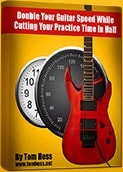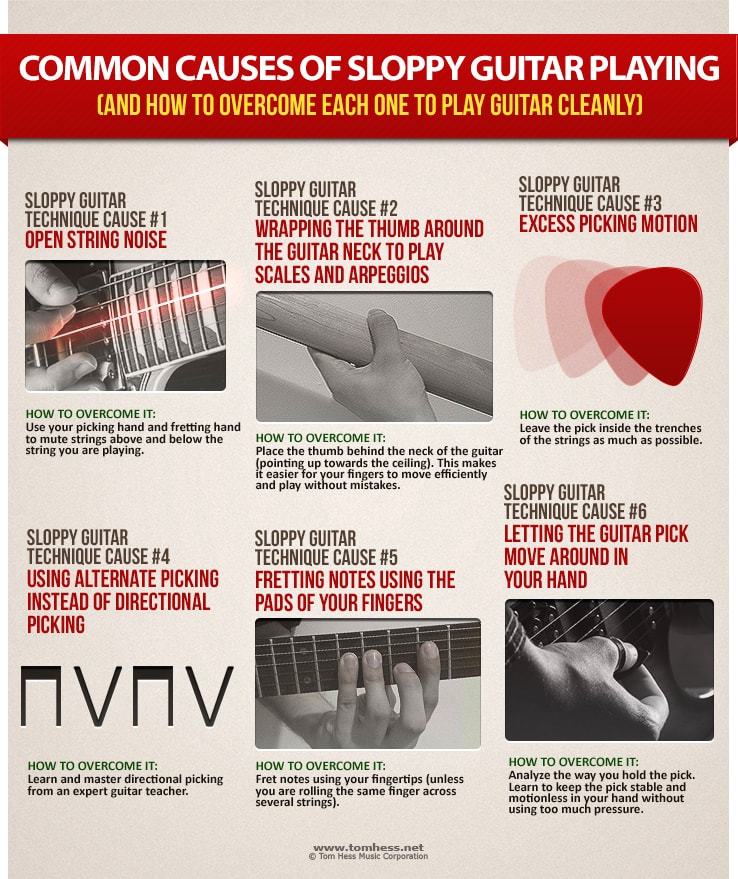How To Fix Sloppy Guitar Technique And Make Your Guitar Playing Accurate And Clean
By Tom Hess
BY AT LEAST 100%

EMAIL TO GET ACCESS
By submitting your info, you agree to send it to Tom Hess Music Corporation who will process and use it according to their privacy policy.
Many of your guitar playing mistakes are caused by sloppy technique. Sloppy technique slows down your progress and makes your playing sound bad. To fix sloppy guitar playing, you need to identify what inefficiencies exist in your guitar technique and learn how to practice to fix them.
Watch this video to see the right way to clean up sloppy playing:
Question: “Tom Hess, how do I know what inefficiencies exist in my guitar technique?”
Answer: There are 2 ways to find this out:
- The easy way: Have an expert guitar teacher analyze your guitar technique and tell you what holds your guitar playing back. This is the fastest, easiest and most proven way to reach your musical goals.
- Analyze your guitar playing yourself (using the steps below). This requires a lot of attention to detail and laser-like focus.
BY AT LEAST 100%

EMAIL TO GET ACCESS
By submitting your info, you agree to send it to Tom Hess Music Corporation who will process and use it according to their privacy policy.
Here are the most common guitar technique (and practice) inefficiencies that cause sloppy guitar playing:

Sloppy Guitar Technique Cause #1: Open String Noise
Sloppy guitar playing is often caused by unwanted open string noise. Vibrating open strings make it hard to hear the notes you are actually playing. Heavy distortion (and playing at a loud volume) makes this problem worse.
Question: “Tom Hess, should I practice guitar with a clean tone to eliminate sloppy string noise from my playing?”
Answer: No! Practice using the tone you want to use in your guitar playing. If you intend to play with distortion, practice with distortion. This makes sloppy string noise easier to hear and easier to correct. More importantly, distortion makes it easy to hear when string noise has been eliminated.
Note: Do NOT practice guitar using effects (such as delay, reverb, chorus, etc.). These effects are for playing guitar, not for practicing.
Question: “Tom Hess, should I simply use less distortion in my guitar playing to manage string noise better?”
Your picking hand can mute string noise in 2 ways:
- By using the thumb to rest on the lower strings to keep them from ringing. Slide the thumb up and down the lower strings, as the pick plays on the higher strings. This is a very simple and secure way to eliminate string noise.
Over time you will develop a thick callus on the side of your thumb (similar to calluses on your fretting hand fingers).
Tip: Use a large pick and have more of the pick digging into the string trench (more on this below). This prevents the thumb from muting the string you are attempting to pick.
- By resting the unused fingers (the ones that aren’t holding the pick) on the higher strings.
Tip: Keep your unused picking hand fingers relaxed and mobile. This makes them available for muting string noise no matter what you are playing. If these fingers are tense, relax them before attempting this technique.
Your fretting hand technique mutes string noise with the pad of the index finger. The finger pad rests on the higher strings. This gives you an extra layer of security to eliminate string noise.
Watch this video to see how to use all 3 muting techniques and make your guitar playing very clean:
Muting both higher and lower strings makes it easy to only hear the notes you want to hear. This is key to playing guitar cleanly.
Sloppy Guitar Technique Cause #2: Wrapping The Thumb Around The Guitar Neck To Play Scales And Arpeggios
Wrapping the thumb around the guitar neck forces your fingers to squeeze together. This makes it harder to play guitar fast and clean.
Placing the thumb behind the neck of the guitar makes your fingers more relaxed, keeps them closer to the strings and makes stretching easier. This makes your motions more efficient and your playing becomes cleaner.
 More Fixes For Sloppy Guitar Playing
More Fixes For Sloppy Guitar PlayingLearn how to improve technique fast and become a clean guitarist.
 How To Improve Guitar Technique
How To Improve Guitar TechniqueLearn how to quickly master guitar technique with these 11 elements.
 Play Guitar Cleaner In 10 Minutes
Play Guitar Cleaner In 10 MinutesPractice this fun guitar drill for ten minutes to sound better than ever.
Guitar string trench is the space between strings. The more your pick stays inside the trenches of the strings, the easier it is to play cleanly (and fast). The more your pick moves away from the strings, the harder it is to play cleanly (and keep your hands in sync).
Thumb muting makes staying inside the string trench very easy. Sliding your thumb up and down the strings keeps the pick in the most efficient position.
Note: Avoid pressing the thumb into the strings. The thumb should apply just enough pressure to mute strings, but no more. Pressing the thumb into the strings tenses up your shoulder and creates sloppy noises on string changes.
Question: “Tom Hess, what about string skipping? How can one keep the pick in the trenches of the strings when skipping strings?”
Answer: To skip strings, the pick moves slightly outside the string trench and moves into the next trench as quickly as possible. The goal is to minimize the distance (and time) the pick spends away from the strings. The more your pick stays inside the string trenches, the more efficient (and clean) your playing becomes.
Sloppy Guitar Technique Cause #4: Using Alternate Picking Instead Of Directional Picking
Alternate picking forces the pick to move a lot more than necessary. Changing strings with alternate picking requires the pick to leave the string trench, change direction and skip over the string you just played. This makes string noise (and sloppy mistakes) more likely.
Directional picking makes your picking motions more efficient and easier to keep clean. It lets you keep the pick in the trenches of the strings, keeps your hands in sync better and prevents sloppy string noise.
(Directional picking also trains the same sweep picking motions that you use to play arpeggios. This makes your practice time a lot more efficient.)
This video shows the right way to do directional picking:Question:” Tom Hess, aren’t there many guitarists who play fast and clean with alternate picking?”
Answer: Yes, there are. However, this does not mean that alternate picking is a superior technique. It only means that someone mastered alternate picking in spite of its inherent disadvantages. Guitarists who master directional picking play just as fast (or faster) as the best alternate pickers… but they practice a fraction of the time to reach this goal.
Learn more reasons why directional picking is superior to alternate picking.

Sloppy Guitar Technique Cause #5: Fretting Notes Using The Pads Of Your Fingers
Fretting notes using the pads of your finger makes your guitar playing sloppy.
Finger pads lack calluses, so more pressure is needed to produce a clear note. The pad often doesn't apply enough force to push the string all the way down. When the string is not pushed down all the way, the note becomes muffled and unclear.
Using more pressure than necessary also creates extra tension in your body that makes playing guitar difficult.
This problem is caused by collapsing the first knuckle of fingers 1 2 and 3, or by extending the pinkie finger too far to fret notes.
Solution: Fret notes using your fingertips (unless you are rolling the same finger across several strings). Fingertips have strong calluses and do not compress as easily. This helps you to consistently fret clear notes without excess tension. Fingertips also transfer force to the string much more efficiently. This makes your guitar playing feel easier.
Question: “Tom Hess: my pinkie finger is not long enough to fret notes on the fingertip. What can I do?”
Answer: Fix your thumb position. Your pinkie finger is long enough to play (no matter how small your hands are). Your thumb is likely not letting the pinkie finger extend its full length. 2 common thumb position mistakes include:
- Wrapping the thumb around the guitar neck to play scales and arpeggios.
- Pointing the thumb towards the head of the guitar.
Place the thumb behind the guitar neck to improve your hand position and make it easier for the pinkie finger to stretch.
This video shows a simple solution to this common problem (starting from 1:53):
Sloppy Guitar Technique Cause #6: Letting The Guitar Pick Move Around In Your Hand
Moving the pick around in your fingers makes it hard to articulate the notes clearly and keep your hands in sync. This causes many sloppy mistakes.
Solution: Analyze the way you hold the pick. Learn to keep the pick stable and motionless in your hand without using too much pressure. It does not take much force to hold the pick securely in place.
Tip: Bringing the pick closer to the wrist joint helps to keep it from moving excessively.
Sloppy Guitar Technique Cause #7: Fretting Notes Too Far Away From The Fret Wire
Fretting notes far away from the frets requires a lot more pressure to produce a clear note. Many guitarists don’t notice how far their fingers drift away from the frets. This happens most often during fast and challenging playing.
Solution: Keep your fingers as close as possible to the fret wire to makes it easy to play guitar clean.
Careful attention to details of your guitar technique helps you avoid this problem.
Steps To Clean Up Sloppy Guitar Playing:
Step 1: Record your guitar playing often. Listen carefully to the recording in headphones. The more you focus during this step, the faster your guitar playing improves.
Step 2: Identify where your guitar playing is sloppy. Isolate the specific notes that don’t sound the way you want them to sound.
Step 3: Determine which elements of sloppy guitar playing are causing your mistakes.
Here is how:
- Select one guitar technique element to pay attention to.
- Make adjustments in your guitar technique to refine that element.
- Listen to how your playing changes as a result. If you notice an improvement, you identified one cause of your sloppy guitar playing.
- Repeat the process for other guitar technique elements described in this article.
Step 4: Refine the guitar technique elements that cause your sloppy playing. Focus on them like a laser until they are mastered.
Use this process regularly to develop flawless guitar technique and play guitar clean.
Now that you know how to clean up sloppy guitar playing, I want to show you how to build lightning fast guitar speed, even if you don’t have much time to practice. Download this free eGuide to learn how to double your guitar speed, so you can play anything you want as fast as you want.
 About Tom Hess: Tom Hess is a guitar teacher, music career mentor and guitar teacher trainer. He teaches rock guitar lessons online to students from all over the world and conducts instructional live guitar training events attended by musicians from over 50 countries.
About Tom Hess: Tom Hess is a guitar teacher, music career mentor and guitar teacher trainer. He teaches rock guitar lessons online to students from all over the world and conducts instructional live guitar training events attended by musicians from over 50 countries.
Study with the best online guitar teacher to reach your musical goals fast.


